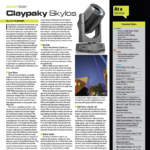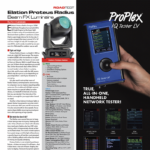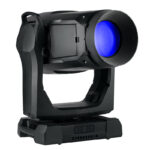It is easy to occasionally lose perspective in this industry. We get focused on our own areas, on the tech that we use every day, and forget that there are other areas that have their own set of unique challenges. In this Road Test, we take a step back and look at a control solution not intended for the largest touring rock shows, but for smaller venues like auditoriums, ballrooms, board rooms — any place that needs reliable yet easy-to-use lighting control that also offers sophisticated control and playback.
Lightronics’ SC-810 is a small DMX controller than offers a full 512-channel universe of control and scene playback capability. A unit of compact, solidly constructed powder-coated steel, it comes in two variants — a wall-mountable version (for mounting flush in a wall or other surface) or a “desktop” version. The control surfaces of both versions are identical.
There are ten small faders on the face of the control surface and eight buttons that set the DMX channel “block” and also provide scene playback. Faders all move quite smoothly, with no discernible “bump” anywhere along the travel path. They have just the right amount of resistance to help prevent inadvertent level changes. In addition, three other control buttons line the right hand side for various functions. There is one 5-pin female DMX on the rear of the unit, which is used for both DMX output and input, and the user will need to supply a male-to-male DMX adapter to use this functionality. There is also a power port on the rear, which accepts either a plug from an included AC adapter for the desktop unit or a four-pin terminal for the in-wall mounted version.
Although there are only ten faders, the operator can access every possible channel through the use of the left-hand buttons. These control which DMX channels the unit’s faders currently control by incrementally advancing the channels in groups of ten. For instance, to control the 151st channel on the universe, the user would press the “+100” button followed by the “+50” button. This would set the fader assignments to 151 through 160. This process might be somewhat complicated for anyone unaccustomed to controlling fixtures in this manner, but the channel-setting functionality is clearly intended to be used for setup by a technician and not live control of an entire universe.

Operating Modes
There are a few different ways to use the SC-810. In the default scene mode, the device acts as a replay unit, with all the buttons and faders acting as recalls for preexisting scenes. These scenes can be recorded by either manually setting levels on the device while in channel mode or by recording incoming DMX from a separate controller. Recording scenes is accomplished via a record button, which is recessed under the housing to prevent accidental overwriting of already-recorded scenes. The end user will need to supply some small tool — the manual recommends a stiff wire or bent paper clip — so they can press the recessed button.
The controller also allows the user to set fade times on any of the eight scene playback buttons with any time between 0 and 55 seconds. In contrast, the ten faders, when acting as playbacks, always operate in real-time manual crossfade mode and cannot have a fade time assigned to their scenes. There is also a blackout feature, accessible from a single button, that will transmit a DMX value of 0 on all 512 channels. It remains latched until pressed a second time to release. This universe-wide 0 level might lead to unexpected effects with intelligent lighting — something to keep in mind when controlling these devices.
During scene recall, multiple scenes will play back in a highest-takes-precedence (HTP) manner. For example, if two scenes are active with a particular light (or attribute) recorded at 80 percent in one scene and at 90 percent in another, the unit will always transmit the higher value to the light or attribute in question. This is, again, especially important to remember for any situation in which the end user is controlling an intelligent fixture, such as a color mixing LED unit or a moving light. Both the playback buttons and the faders can be used at the same time to combine scenes into a final output look. This functionality can be used to create a “control group” — for instance, with a group of LED fixtures that all have a master dimmer. By assigning a scene in which the master dimmer is at 100 percent and assigning the red, green, and blue attributes to faders, the user could set a color using the faders without affecting the brightness.
It is also possible to use the controller in conjunction with a separate DMX console, utilizing the DMX port on the unit as an input. Lightronics recommends isolating the controller using a splitter when on a network with other devices. When another controller is transmitting DMX on the same data chain as the SC-810, the SC-810 will automatically stop transmitting and begin receiving DMX, and the controller can capture this incoming data and record it into scenes. This is a very useful feature for any end users who need especially precise control or are controlling sophisticated devices, such as media servers, by allowing the user to save data transmitted from an external console. When any connected external controller stops transmitting DMX, the SC-810 will resume control. If a scene was active on the SC-810 before receiving a DMX input, the SC810 will restore to that scene. If a scene was not active, the SC-810 will continue to transmit the last levels sent by the external console. This functionality should help prevent unwanted changes in level.
Another feature available to users is the ability to park channels at or above one percent. When parked, a channel will remain at its parked value regardless of whether the controller is in channel or scene mode, and cannot be overridden by either scene recalls or incoming DMX control from another console. In my opinion, the ability to keep a channel at zero percent might increase the utility of the parking feature somewhat, but its absence is not terribly limiting.
Reliable and simple control for venues such as board rooms, hotel meeting and event spaces, or school auditoriums is an essential component of any system, one which the SC-810 should have no problem doing. Once programmed and set up, it can serve as a simple and easy control solution that can be used to very quickly and efficiently get a look going on stage or in a room. It features easy-to-use playback and scene recall without sacrificing the sophisticated control required for larger or mixed-fixture rigs with the capability to control more complex intelligent or LED lights, and it should have no trouble integrating into existing smaller-scale control networks.
At a Glance:
A Compact Control Solution
The SC810 is a compact and simple-to-use DMX controller and scene playback device, with control of up to 512 channels of DMX and 18 user defined, recordable scenes. It can be used as a replay unit, to set fade times and for quick and easy blackouts (one button, two pushes). Well-suited as a control solution for board rooms, hotel meeting and event spaces or school auditoriums, it can be programmed for use as an efficient control solution for playback and scene recall.
PROS: Complete control of an entire universe. Can input and save data from another controller. Hidden record button is perfect for house light usage in ballrooms.
CONS: Cannot park a channel at zero percent.
SPECS
Wall Mount Model:
- Size: 9.125” x 4” x 2.5” (WxHxD)
- Weight 0.9 lbs.
Desktop Model:
- Size: 12.125” x 2” x 5” (WxHxD)
- Weight: 3 lbs.
MSRP: $1,329



